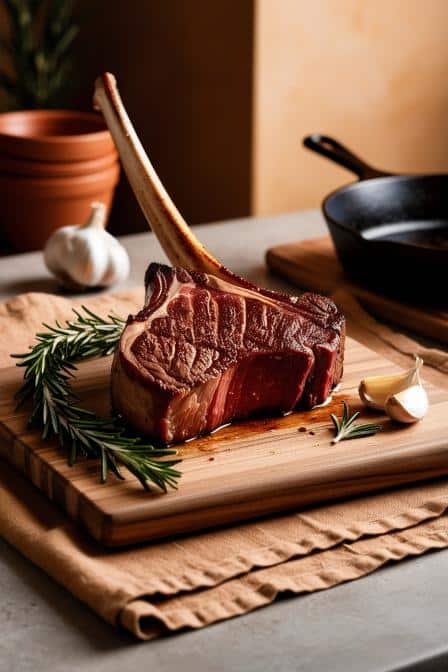I remember the first time I cooked a tomahawk steak. Not in a restaurant kitchen, but at home. Just me, a ridiculously oversized cut of beef, and a tiny oven that had no business holding it. The bone barely fit in. It stuck out like a sword handle from some medieval feast. But when I pulled it out—mahogany crust, sizzling fat, rich beef aroma—oh, it was worth every awkward shuffle to make it fit.
The tomahawk steak isn’t just meat. It’s drama. It’s theatre on a plate. This cut—essentially a ribeye with the long rib bone still attached—commands attention before it even hits the pan. That bone is no decoration; it’s part of the magic, insulating the meat, adding subtle depth as it roasts.
Cooking it in the oven? That’s where precision matters. Unlike the slap-and-go grill method, oven-baking lets you control every stage—slow bringing it up to temp, then blasting the surface into a crust that could make a butcher tear up. It’s also forgiving if you know your cues. And today, we’re not just cooking it; we’re mastering it.
What Makes This Recipe Special
A tomahawk steak isn’t like tossing a thin sirloin on the stove. It’s a thick, bone-in ribeye, usually 2–3 inches thick, sometimes over 2kg. You can’t rush it. You can’t hide mistakes. The oven method gives you slow, even heat—preserving juiciness inside while building a deep, crusty sear outside.
We’ll use a reverse-sear approach: gentle oven roast, then a blistering finish in a pan or broiler. This prevents that dreaded grey ring of overcooked meat around the edges. It’s also a technique that works for any thick steak. But with a tomahawk, it feels almost ceremonial.
We’ll talk ingredient choices, substitution tricks, and why details like salt timing or pan type can make or break the result.
Ingredients & Substitutions
Here’s the base recipe. We’ll keep it simple, because the meat does the talking.
| Ingredient | Measurement | Notes & Substitutions |
|---|---|---|
| Tomahawk steak | 1 steak, 1.2–1.5 kg | Look for USDA Prime, Wagyu, or grass-fed for best marbling. |
| Kosher salt | 2 tbsp | Sea salt works, but avoid fine table salt—it over-seasons fast. |
| Freshly cracked black pepper | 1 tbsp | Can use green peppercorns for a lighter spice. |
| Olive oil | 2 tbsp | Avocado oil or beef tallow are excellent high-smoke alternatives. |
| Garlic cloves | 4, smashed | Replace with garlic powder if needed, but fresh gives deeper aroma. |
| Fresh rosemary | 2 sprigs | Thyme or sage also pair beautifully with beef. |
| Unsalted butter | 4 tbsp | Clarified butter resists burning better during the sear. |
Ingredient insights:
Fresh rosemary behaves differently than dried—it releases aromatic oils into the butter when heated, rather than giving a dusty herb taste. That’s key when basting. Using beef tallow instead of olive oil? Expect a more old-school steakhouse flavor—pure beef on beef.
Step-by-Step Instructions
Step 1 – Prep the Steak
Take the tomahawk out of the fridge at least 1 hour before cooking. Room temperature meat cooks more evenly. Pat it dry like you mean it. Moisture is the enemy of crust.
Step 2 – Season Boldly
Generously coat both sides with kosher salt and black pepper. Don’t just sprinkle; massage it into every crevice. With a cut this thick, under-seasoning is the rookie mistake.
Step 3 – Preheat the Oven
Set to 120°C (250°F). This low heat ensures gradual cooking. Place a wire rack over a baking tray to allow air circulation—no soggy bottoms here.
Step 4 – Slow Roast
Place the steak on the rack, bone pointing toward the back of the oven. This helps heat distribute more evenly. Roast until the internal temp is 10–12°C (18–22°F) below your final target—about 46°C (115°F) for medium-rare. Use a meat thermometer; guessing is for gamblers.
Step 5 – Rest Before the Sear
Pull it out and let it rest, uncovered, for 10–15 minutes. This pause lets surface moisture evaporate and juices settle.
Step 6 – Sear with Intention
Heat a heavy cast iron skillet until it’s properly angry-hot. Add oil (or beef tallow), then the steak. Sear 1–2 minutes per side, pressing gently for full contact. Add butter, garlic, and rosemary, basting continuously. That sizzling aroma? That’s the point you know you’re doing it right.
Step 7 – Check Temp & Rest Again
Aim for 54°C (130°F) internal for medium-rare. Rest again for 5–7 minutes before slicing, bone still attached for the reveal.
Common mistakes to dodge:
- Flipping too soon—wait for the crust to release naturally.
- Overcrowding the pan—this drops temperature and prevents a good sear.
- Using cheap nonstick pans—they can’t handle the heat.
Cooking Techniques & Science
Why Reverse Sear Works
Traditional searing first then roasting? It’s fine, but with thick cuts, the outside overcooks before the inside reaches target. Reverse searing slowly brings the interior up to temp, then applies intense heat briefly—so the crust forms without drying out the core.
Bone Advantage
The bone acts as insulation, slowing heat transfer on one side. This means the meat near the bone will be slightly rarer. Some chefs call that the “chef’s cut.” The flavor near the bone is deeper, meatier, almost sweet.
Salt Timing
Salting early (at least 40 minutes before cooking) draws out moisture, then reabsorbs it, seasoning deeper. Last-minute salting? Only seasons the surface.
Tools That Matter
Cast iron holds heat like a vault, giving a consistent sear. A thin pan loses heat when the steak hits it, steaming instead of browning. An instant-read thermometer is non-negotiable—your eyes can’t see doneness.
How to Store & Reheat
If you somehow have leftovers (rare, literally and figuratively), store slices in an airtight container in the fridge up to 3 days. Wrap tightly in foil before reheating to prevent drying.
Best reheating method:
Warm in a low oven (120°C / 250°F) until just heated through, then give it a quick sear in a hot pan to revive the crust. Microwaving? Only if you enjoy shoe-leather steak.
Variations & Substitutions
- Herb Variations: Swap rosemary for sage, oregano, or even a hint of tarragon for a French twist.
- Spice Rub: Add smoked paprika, cayenne, or crushed mustard seed for a bolder flavor profile.
- Dry Aging: If you have access to a dry-aged tomahawk, expect intensified beefiness and nutty undertones.
- No Oven Option: Use a two-zone grill—indirect heat to cook through, direct heat for the sear.
Serving & Pairing Suggestions
Serve it whole at the table for that primal “wow” moment, then slice against the grain into thick ribbons. Arrange them overlapping, bone leaning on the side like a trophy.
Pair with roasted garlic mashed potatoes, charred asparagus, or a crisp green salad to balance the richness. For drinks, a bold Cabernet Sauvignon or Syrah stands up to the steak’s power. Beer drinker? A dark porter or stout complements beautifully.
Even something as simple as flaky sea salt sprinkled at the table adds a final pop.
Best Time to Serve
A tomahawk steak is not Tuesday-night pasta. It’s celebration food. Birthdays, promotions, holidays, or that moment you just want to feel like royalty. It’s also perfect for small dinner parties—one steak sliced for four people alongside generous sides.
Conclusion
An oven-baked tomahawk steak is more than cooking—it’s craftsmanship. Respecting the meat, controlling temperature, and understanding the science behind every step is what turns a big cut into an unforgettable meal.
Key takeaways? Patience wins over brute heat. Tools matter as much as ingredients. And always—always—rest before slicing.
You don’t need a commercial kitchen to make this masterpiece. Just care, a good pan, and the willingness to get a little smoky for greatness.
FAQs
1. Can I cook a frozen tomahawk steak in the oven?
It’s possible, but results suffer. Always thaw completely for even cooking.
2. How do I know when it’s perfectly done?
Use a meat thermometer. For medium-rare, pull at 54°C (130°F) after the sear.
3. Can I marinate a tomahawk steak?
Yes, but keep it short—2–4 hours max. Over-marinating can mask the beef flavor.
4. Why is my crust not forming?
Pan wasn’t hot enough or steak was too wet. Pat dry and preheat pan thoroughly.
5. How thick should a tomahawk steak be for oven baking?
Ideally 2–2.5 inches. Thinner steaks can overcook quickly with this method.
If you want, I can also give you a chef’s shortcut version of this recipe in under 200 words for quick reference while cooking. Would you like me to prepare that?

